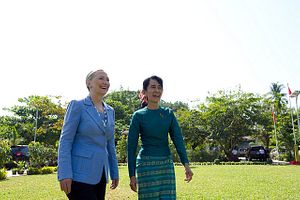In 2007 U.S. presidential candidate Barack Obama, then-U.S. Senator from Illinois, called for a new vision of U.S. leadership:
Today, we are again called to provide visionary leadership. This century’s threats are at least as dangerous as and in some ways more complex that those we have confronted in the past…To recognize the number and complexity of these threats is not to give way to pessimism. Rather, it is a call to action. These threats demand a new vision of leadership in the twenty-first century – a vision that draws from the past but is not bound by outdated thinking.
In recruiting his presidential rival to execute his foreign policy, President Obama entrusted then-U.S. Secretary of State Hillary Clinton to introduce the concept of “pivot to Asia” – a new strategic shift of American geopolitical focus from Europe and the Middle East to Asia. In her 2011 Foreign Policy article “America’s Pacific Century,” Hillary essentially articulated her and the Obama administration’s vision for the Asia Pacific region.
Democrats recognize Asia’s strategic relevance. Under President Bill Clinton’s administration (1993-2001), the concept of “forward-deployment” was a key component of an “engagement and expansion” approach outlined in the U.S. Department of Defense 1995 East Asia Strategy Report. Hillary’s Asia strategy calls for “forward-deployed diplomacy” – an upgrade of its 1995 precursor with an expanded diplomacy dimension – fitted to a post-September 11 world where counterterrorism had become the focal point of U.S. foreign policy.
As the current conceptual owners of the U.S. rebalance to Asia, Democrats have yet to make the rebalance a reality beyond rhetoric. Asia policy highpoints during Clinton’s tenure include support for Myanmar’s democracy activist Aung San Suu Kyi and the Burmese Spring as a model for North Korea (2011); the release of Chinese civil rights activist Chen Guangcheng (2012); the call for resolution of the South China Sea code of conduct (2012) and the impending Trans-Pacific Partnership (TPP) legislation. In assessing concrete breakthroughs, the Burmese Spring has not achieved the five measures of political reform that Obama elucidated in 2014. Clinton’s expedient handling of the Chen Guangcheng averted major confrontation between Washington and Beijing during the 2012 U.S.-China Strategic and Economic Dialogue. But according to Chen’s account, Clinton’s staff yielded too much to Beijing. While both sides have their interpretation of how the incident was resolved, the larger question is how or if a Hillary White House would address China’s human rights abuses in a consequential way. Despite Clinton’s exhortation for moving forward on a South China Sea code of conduct, China has further ramped up its muscle-flexing on the issue. On balance, Hillary’s record on Asia scores high on promulgating lofty goals, but low on delivering substantive change.
Congressional legislation on TPP poses a major challenge to Hillary and the Democrats. Current friction among Democrats over TPP reveals rifts between progressives and the President, who is intent on sealing the centerpiece of his Asia policy record. In the opening salvos between Obama and U.S. Senator Elizabeth Warren on whether TPP benefits the United States, TPP has put Hillary on a tightrope. In this balancing act, Hillary faces the first of many major decision-making tests on staking a position during her campaign. The bigger issue, however, is whether Hillary’s actions or non-actions will exacerbate fault-lines within the Democratic party – Obama fighting for his legacy and Warren fighting for the progressive soul of the party. While Hillary’s past foreign policy record is tied to championing TPP, her future path to the presidency hinges on support from the party’s progressive quarters.
The Democrat’s internal debate on TPP is beneficial for the American public and necessary for Congress. It also offers a timely opportunity for Hillary to begin signaling a post-Obama vision for Asia. But, perhaps more immediately, it provides indicators of how real the Hillary “reset” is. In re-branding herself as the champion of everyday Americans, will her positions boost her Main Street America cred or will she revert to a default mode of political hedging and calculating? Team Hillary is bracing for the brewing maelstrom over new revelations concerning the Clinton family’s foundation funding linkages. With complications and “distractions” on both flanks, the veteran politician will maintain resilience under fire. But the greater challenge is for the Clinton campaign to show whether a new-and-improved Hillary can convincingly exhibit presidential qualities in what increasingly may become a political war of attrition. Staunch, all-weather Democrat donors and supporters will endure the impending fallout, but skeptical progressives, independents and prospective constituents may not.
Democrats have a chance to uphold the mantle of U.S. rebalance to Asia. Seizing this chance, however, might be enshrouded in a contest between Hillary’s not very hard choices: “Reset” – a genuine shift to new vistas and innovative ways of leadership – and “Default” – outdated thinking and tactical defensive posturing.
Mercy A. Kuo is an advisory board member of CHINADebate and was previously director of the Southeast Asia Studies and Strategic Asia Programs at the National Bureau of Asian Research. Angie O. Tang is Senior Advisor of Asia Value Advisors, a leading venture philanthropy advisory firm based in Hong Kong.

































